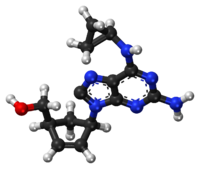User:Mr. Ibrahem/Abacavir
 | |
 Chemical structure of abacavir | |
| Clinical data | |
|---|---|
| Pronunciation | /əˈbækəvɪər/ |
| Trade names | Ziagen, others[1] |
| AHFS/Drugs.com | Monograph |
| MedlinePlus | a699012 |
| License data | |
| Pregnancy category |
|
| Routes of administration | By mouth (solution or tablets) |
| Drug class | Nucleoside analog reverse-transcriptase inhibitors (NRTIs)[1] |
| Legal status | |
| Legal status | |
| Pharmacokinetic data | |
| Bioavailability | 83% |
| Metabolism | Liver |
| Elimination half-life | 1.54 ± 0.63 h |
| Excretion | Kidney (1.2% abacavir, 30% 5'-carboxylic acid metabolite, 36% 5'-glucuronide metabolite, 15% unidentified minor metabolites). Fecal (16%) |
| Identifiers | |
| |
| Chemical and physical data | |
| Formula | C14H18N6O |
| Molar mass | 286.339 g·mol−1 |
| 3D model (JSmol) | |
| Melting point | 165 °C (329 °F) |
| |
| |
| (verify) | |
Abacavir, sold under the brand name Ziagen, is a medication used to prevent and treat HIV/AIDS.[1][4] Similar to other nucleoside analog reverse-transcriptase inhibitors (NRTIs), abacavir is used together with other HIV medications, and is not recommended by itself.[5] It is taken by mouth as a tablet or solution and may be used in children over the age of three months.[1][6]
Abacavir is generally well tolerated.[6] Common side effects include vomiting, trouble sleeping, fever, and feeling tired.[1] More severe side effects include hypersensitivity, liver damage, and lactic acidosis.[1] Genetic testing can indicate whether a person is at higher risk of developing hypersensitivity.[1] Symptoms of hypersensitivity include rash, vomiting, and shortness of breath.[6] Abacavir is in the NRTI class of medications, which work by blocking reverse transcriptase, an enzyme needed for HIV virus replication.[7] Within the NRTI class, abacavir is a carbocyclic nucleoside.[1]
Abacavir was patented in 1988, and approved for use in the United States in 1998.[8][9] It is on the World Health Organization's List of Essential Medicines.[10] It is available as a generic medication.[1] The wholesale cost in the developing world as of 2014 is between US$0.36 and US$0.83 per day.[11] As of 2016 the wholesale cost for a typical month of medication in the United States is US$70.50.[12] Commonly, abacavir is sold together with other HIV medications, such as abacavir/lamivudine/zidovudine, abacavir/dolutegravir/lamivudine, and abacavir/lamivudine.[6][7] The combination abacavir/lamivudine is also an essential medicine.[10]
References[edit]
- ^ a b c d e f g h i j "Abacavir Sulfate". The American Society of Health-System Pharmacists. Archived from the original on 21 August 2017. Retrieved 31 July 2015.
- ^ "ABACAVIR = ABC oral - Essential drugs". medicalguidelines.msf.org. Archived from the original on 27 August 2021. Retrieved 25 August 2020.
- ^ "WHOCC - ATC/DDD Index". www.whocc.no. Archived from the original on 7 August 2020. Retrieved 21 September 2020.
- ^ "Drug Name Abbreviations Adult and Adolescent ARV Guidelines". AIDSinfo. Archived from the original on 9 November 2016. Retrieved 8 November 2016.
- ^ "What Not to Use Adult and Adolescent ARV Guidelines". AIDSinfo. Archived from the original on 9 November 2016. Retrieved 8 November 2016.
- ^ a b c d Yuen GJ, Weller S, Pakes GE (2008). "A review of the pharmacokinetics of abacavir". Clinical Pharmacokinetics. 47 (6): 351–71. doi:10.2165/00003088-200847060-00001. PMID 18479171. S2CID 31107341.
- ^ a b "Nucleoside reverse transcriptase inhibitors (NRTIs or 'nukes') - HIV/AIDS". www.hiv.va.gov. Archived from the original on 9 November 2016. Retrieved 8 November 2016.
- ^ Fischer, Janos; Ganellin, C. Robin (2006). Analogue-based Drug Discovery. John Wiley & Sons. p. 505. ISBN 9783527607495. Archived from the original on 8 September 2017.
- ^ Kane, Brigid M. (2008). HIV/AIDS Treatment Drugs. Infobase Publishing. p. 56. ISBN 9781438102078. Archived from the original on 8 September 2017.
- ^ a b World Health Organization (2019). World Health Organization model list of essential medicines: 21st list 2019. Geneva: World Health Organization. hdl:10665/325771. WHO/MVP/EMP/IAU/2019.06. License: CC BY-NC-SA 3.0 IGO.
- ^ "International Drug Price Indicator Guide". ERC. Archived from the original on 29 March 2019. Retrieved 20 November 2016.
- ^ "NADAC as of 2016-12-07 | Data.Medicaid.gov". Centers for Medicare and Medicaid Services. Archived from the original on 21 December 2016. Retrieved 12 December 2016.
